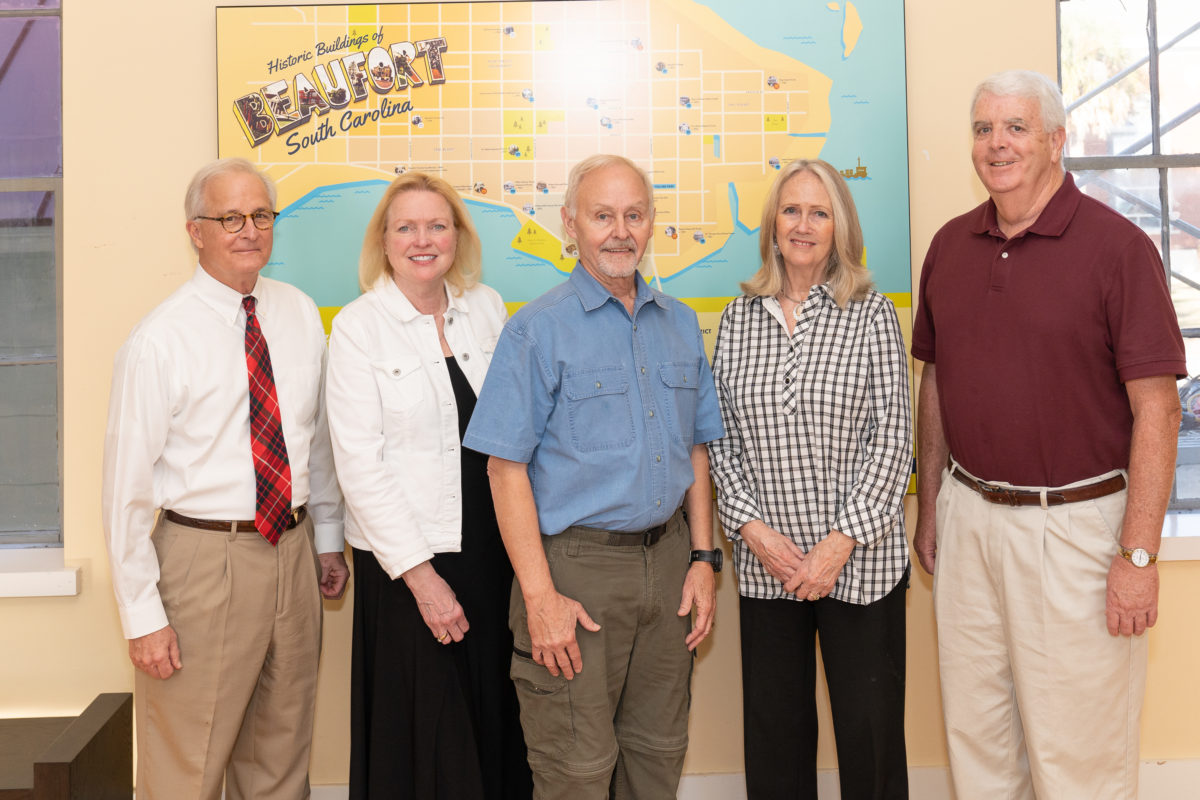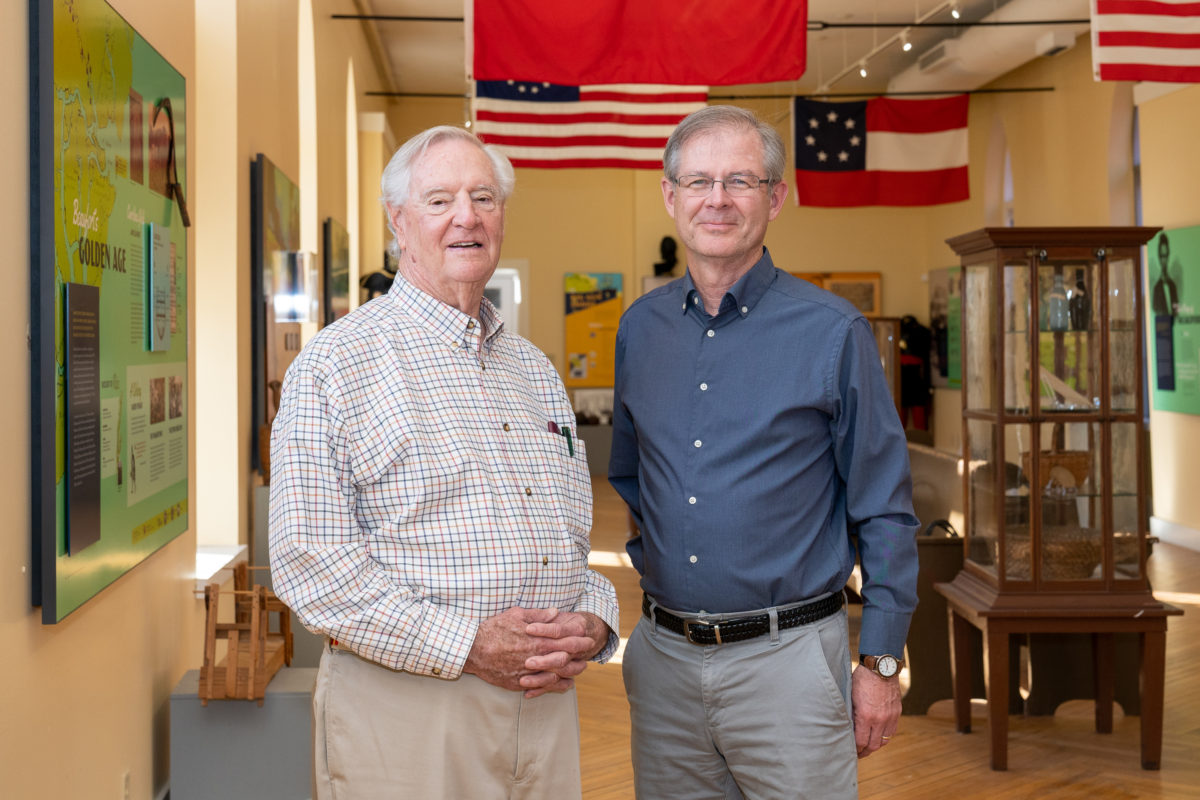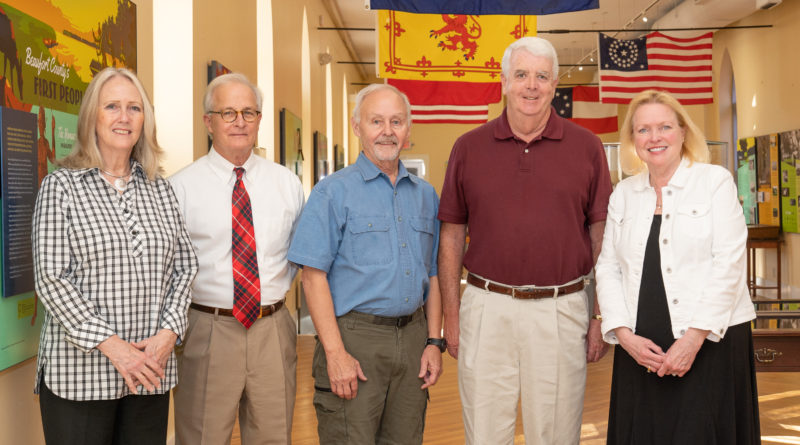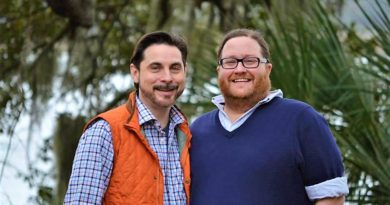PORT ROYAL SOUND AND BEAUFORT COUNTY
Their Pivotal Role in Shaping America’s History
story by CAROL LAUVRAY photos by SUSAN DELOACH
Renowned local historian Lawrence S. Rowland, distinguished professor emeritus of history at the University of South Carolina Beaufort, describes Beaufort and the Port Royal Sound area saying, “The Sea Islands form a unique geography and history on the North American continent. The natural bounty of the estuaries supported millennia of Native Americans as well as the earliest Spanish, French and English colonists. The same environment produced great wealth from long-staple Sea Island cotton and sustenance for America’s first Freedmen. Today it produces a bounty from tourists and retirees. The Sea Islands are a unique and magical place.”
The Port Royal Sound Area is Unique
The Port Royal Sound area is an Inland Maritime Ecosystem, encompassing both Port Royal Sound and Calibogue Sound. Its watershed includes all of the land and waters that drain into the Port Royal Sound. The area is unique because:
It is an Inland Sea. Its “rivers” are salty fingers of the Atlantic Ocean, resulting in a marine preserve that is surrounded by land. Very little freshwater enters Port Royal Sound and its tributaries. Therefore the salinity of incoming tides remains high.

It is the deepest natural harbor in the Southeast, with sections of the Sound ranging from 30 to 60 feet.
It has the highest tides in the Southeast, averaging 8 feet, but at times exceeding 10 feet.
Its high salinity waters, deep channels, high tidal amplitude, and extensive salt marsh support a great biodiversity of marine species living in the Port Royal Sound area.
Dr. Chris Marsh, the executive director of the Spring Island Trust since 1998 and the founding director of the Lowcountry Institute, says that three geographic factors have influenced the history of
Beaufort—the Port Royal Sound’s deep harbor, its high tides, and its mild climate.
Deep Harbor: The Port Royal Sound’s deep harbor, which is protected by a series of islands with ample freshwater, attracted Spanish, French, and English explorers and settlers beginning in the early 1500s.
High Tides: The Lowcountry region of South Carolina has the highest tides in the Southeast. The effect of these high tides on the coastal or black rivers flowing into the Lowcountry sounds allowed early settlers to develop a new method of cultivating rice along coastal freshwater rivers. As a result, the landscape was dramatically transformed, and the region’s dependence on slave labor grew. The area’s high tides create a unique environment favorable to the salt marsh ecosystem here, which is home to many forms of wildlife, including birds, shrimp, oysters, and many varieties of fish.
Mild Climate: Having a sustainable food supply was essential for successful colonization of the area and the development of export markets. The Port Royal Sound area’s warm climate made it possible to grow crops throughout the year and was ideally suited for a plantation economy. An early type of red rice, most likely brought here by slaves from Africa’s rice coast, was well suited to this climate, as was Carolina Gold rice, which arrived via Madagascar. Experimentation of other crops such as indigo and cotton plants brought from the Caribbean resulted in the eventual highly successful cultivation of these crops.
Dr. Marsh states, “Most of what I’ve learned about Beaufort’s history has been at the feet of Larry Rowland. I read his first volume [Dr. Rowland is the co-author of The History of Beaufort County, South Carolina, Volume 1, 1514 -1861, with Alexander Moore and George C. Rogers, Jr.] a couple of times and then had the opportunity to ask him lots of questions.”
Dr. Marsh shared four significant themes of Beaufort’s history that emerged as a result of his discussions with Dr. Rowland:
Spanish and early European exploration and settlement of the Port Royal Sound area was influenced by the unique geography, and ecology found here.
The mild climate in this area influenced the agricultural crops that were grown here, which resulted in a plantation economy and the institution of slavery that supported it.
The deep harbor of Port Royal Sound offered European explorers and settlers a strategic advantage. The deep harbor here influenced the Union to take the area early in the Civil War and make it the hub of the Federal blockade efforts of the southeastern coast. The Union’s occupation led to the liberation of the area’s enslaved people and to the beginning of the Reconstruction Era here, laying the Foundation for the Civil Rights Movement of the 20th century.
The unique “biogeography” of Port Royal Sound has led to the “coastal invasion” of transplanted Northerners to Beaufort, which began in the 1970s and continues today.

Beaufort History Museum’s Newest Exhibit Now Under Development
Beaufort History Museum (BHM), located on the second floor of the historic Arsenal on Craven Street, is in the midst of a multi-year project of completely renovating the Museum’s exhibit space to showcase the City of Beaufort’s collection of artifacts, documents, and photos. As part of that project, a new exhibit display is currently being developed to explore the Beaufort area’s geography, ecology, and climate and examine how Beaufort’s history has been shaped by those elements.
The content for this new exhibit is being developed by BHM’s Exhibit Committee, with the guidance, consultation, and review of the Museum’s expert advisors on the history of Beaufort, Dr. Lawrence Rowland, professor emeritus of history at USCB, and Dr. Stephen Wise, director of the Parris Island Museum and Cultural Resource Manager for the Marine Corps Recruit Depot. Dr. Chris Marsh, executive director of both the Spring Island Trust and the LowCountry Institute, is serving as the Museum’s expert advisor on the geography, ecology, and climate of the Port Royal Sound area for the new exhibit. Members of the Museum’s Exhibit Committee who have been working to develop the content for the new exhibit display since early fall include: Phil Cromer, Gary Hall, Tom Kelley, Katherine Lang, Carol Lauvray, Kathy Mixon, and Bill Skipper. HW Exhibits of Charleston will construct and install the new exhibit.
“The Museum is indebted to our three advisors—Drs. Lawrence Rowland, Stephen Wise, and Chris Marsh—for sharing their expertise, time, and talent to assist us in developing our new exhibit display. It will explain how the Port Royal Sound area’s geography, ecology, and climate have shaped Beaufort’s history,” said BHM Exhibits Committee member Carol Lauvray.
The Port Royal Sound has Shaped 500 Years of Beaufort’s History
In the early 1500s, the Spanish discovered Port Royal Sound while exploring the New World. They realized the strategic advantages of its location and its deep harbor, protected by a series of islands containing fresh water. The Gulf Stream, in combination with the westerly trade winds, provided a northeasterly current to carry their ships from the Caribbean and South Atlantic across the Atlantic home to Europe. Port Royal Sound afforded the Spanish a strategic stop on the route to transport Mexican and Peruvian silver and gold back to Spain. This plunder made Spain the wealthiest and most powerful country in Europe at that time.
The French arrived here in 1562, and later the English, whose superior navy ultimately claimed the Port Royal Sound area. They were stunned by the unmatched beauty and agricultural potential of the area, with its rich and diverse ecosystem of plant, animal, and marine life. The soil here was rich for cultivation, and the forests were full of wildlife. An extensive network of rivers and streams from the ocean fingers of Port Royal Sound and nearby estuaries created waterways for the transportation of people and goods, including deer pelts and lumber for trade.

The Founding of Beaufort and its Plantation Economy
The English who settled in this area in the late 1600s and early 1700s realized that the climate and geography here were similar to those of the coast of West Africa, where valuable crops such as rice, indigo, and cotton were grown. However, for these crops to be lucrative required the importation of enslaved Africans who possessed the specialized skills needed to cultivate the crops. The institution of slavery to support agriculture here proved to be extremely successful economically for the Lowcountry planters, who became some of the wealthiest people in America before the Revolution and during the years leading up to the Civil War. Ultimately, Beaufort County planters were instrumental in South Carolina seceding from the Union and in initiating the War Between the States.
Beaufort County’s Role during the Reconstruction Era and the Civil Rights Movement
In early November 1861, just months after the onset of the Civil War, a massive Union naval force attacked and quickly overcame the two Confederate forts guarding the entrance to Port Royal Sound. Beaufort and its Sea Islands were the first places in the Deep South captured by Union forces. Control of Port Royal Sound’s deep harbor allowed the Federal navy to blockade the southeastern coast, preventing Confederate vessels from carrying in military supplies from Europe and shipping cotton from Charleston and Savannah to pay for these munitions.
Federal forces occupied Beaufort and the Sea Islands for the rest of the war, ending the slave-based economy in Beaufort County, liberating those who were enslaved here, and initiating the Reconstruction Era in Beaufort County. With the war still underway elsewhere in the South, the Port Royal Experiment began here in 1862, when the Federal Government employed superintendents to operate the abandoned plantations by hiring Freedmen to grow cotton that was sold for the war effort. At the same time, private Freedmen organizations dispatched teachers, ministers, doctors, and other personnel to assist and educate the former slaves. The Freedmen associations operated schools, distributed rations, and clothing, and provided medical care.
After the Civil War, the majority of Beaufort County’s population was African American, and most of the elected officials governing the County until the 1890s were African American. During the period from 1873 to 1893, the Port Royal Sound area was a leader in phosphate mining, timbering, maritime commerce, and cotton production, due principally to the stable workforce of those who were formerly enslaved and the completion of the Port Royal Railroad in 1873. However, that period of prosperity began its decline with the Great Hurricane of 1893, which killed more than 2,000 people and decimated the local infrastructure and crops, as well as the industries of timbering and phosphate mining. The arrival of the boll weevil caused the demise of what was left of the cotton industry here. As a result of these events, Beaufort County’s economy was depressed during the first half of the 20th century.
Penn School, established at the beginning of the Reconstruction Era in1862, continued to educate the descendants of Freedmen through the first half of the 20th century until the school closed in 1953. Redesignated as Penn Center, it became a social, cultural, and historical institution for the Sea Island community on Saint Helena Island. During the 1960s, Dr. Martin Luther King, Jr. and members of the Southern Christian Leadership Conference used Penn Center to hold retreats and conduct strategic planning sessions for the Civil Rights Movement.
In January 2017, President Obama established the Reconstruction Era National Monument in Beaufort County to acknowledge its pivotal role in ending slavery in America and establishing civil rights for African Americans. The National Monument was redesignated as the Reconstruction Era National Historical Park in 2019.

The Coastal Invasion
During the second half of the 20th century, Beaufort County’s economy again began to flourish due to the presence of the military, preservation efforts of historic structures, local development, and conservation efforts to preserve the area’s natural resources. The coastal beauty, geography, mild climate, and rich history here began to draw large numbers of Northerners to relocate to Beaufort County and to live in developments, such as Sea Pines on Hilton Head Island, and Fripp Island and Dataw Island near Beaufort. In addition, growing numbers of tourists were coming to visit the area. This “coastal invasion” of Northerners and tourists to the Port Royal Sound area has escalated over recent years, resulting in Beaufort County becoming one of America’s fastest-growing regions in terms of population.
Managing development here has become a priority. Beaufort County natives, as well as newcomers to the area, are advocates for protecting the environment and natural resources of the Port Royal Sound area. In 1978, a group of concerned citizens successfully prevented the development of a chemical plant along Port Royal Sound. Concern about oyster beds closing for harvesting led to citizen involvement in the protection of local water quality. In 2001, the Friends of the Rivers formed with the mission of water quality protection and land planning. This group evolved in 2011 into a nonprofit organization, the Port Royal Sound Foundation. The Foundation works to educate local citizens about the uniqueness of Port Royal Sound and the marine life it supports, and educates local communities about how they must act in ways that prevent storm water and pollutants from adversely affecting the waters and marine life of the Sound.
The LowCountry Institute (LCI) is another local nonprofit group. Its website states that LCI “…was established in 1998 to educate the community on the value of the unique environments of the Low Country region. The Institute promotes effective management of privately owned natural areas and works to protect water quality and marine resources of Port Royal Sound. LCI now operates as the outreach initiative of the Spring Island Trust.”
Among other educational and research programs, the LowCountry Institute offers a Master Naturalist program. The organization’s website provides a wealth of information, including the award-winning Coastal Kingdom TV series, co-produced with the Beaufort County Channel.
To learn more about these organizations, visit: www.portroyalsoundfoundation.org
www.lowcountryinstitute.org




